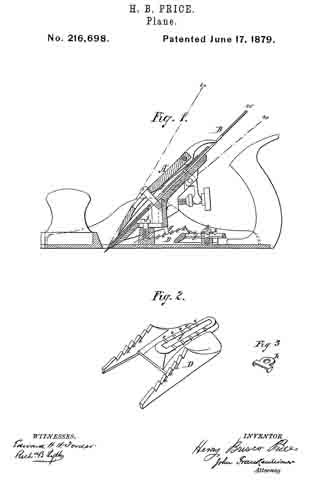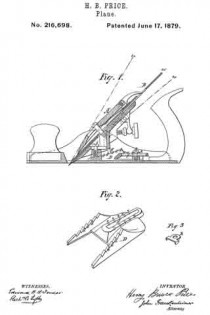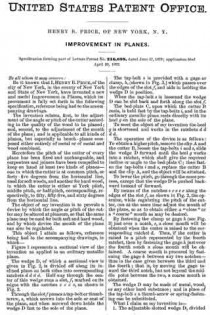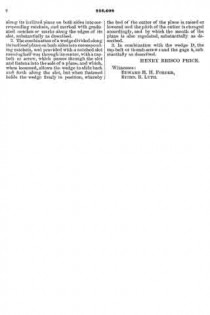No. 216,698 – Improvement In Planes (Henry B. Price) (1879)

UNITED STATES PATENT OFFICE.
_________________
HENRY B. PRICE, OF NEW YORK, N. Y.
IMPROVEMENT IN PLANES.
_________________
Specification forming part of Letters Patent No. 216,698, dated June 17, 1879; application filed April 28, 1879.
_________________
To all whom it may concern:
Be it known that I, HENRY B. PRICE, of the city of New York, in the county of New York and State of New York, have invented a new and useful Improvement in Planes, which improvement is fully set forth in the following specification, reference being had to the accompanying drawings.
The invention relates, first, to the adjustment of the angle or pitch of the cutter according to the quality of the wood to be planed; and, second, to the adjustment of the mouth of the plane; and is applicable to all kinds of planes, but especially to bench-planes composed either entirely of metal or of metal and wood combined.
Heretofore the pitch of the cutter of every plane has been fixed and unchangeable, and carpenters and joiners have been compelled to keep on hand at least two kinds of planes — one in which the cutter is at common pitch, or forty-five degrees from the horizontal line, used for soft woods, and another for hard wood, in which the cutter is either at York pitch, middle pitch, or half-pitch, corresponding, respectively, to fifty, fifty-five, and sixty degrees from the horizontal line.
The object of my invention is to provide a device by which the angle or pitch of the cutter may be altered at pleasure, so that the same plane may be used for both soft and hard wood, and by which device the mouth of the plane can also be regulated.
This object I attain as follows, reference being had to the accompanying drawings, in which —
Figure 1 represents a sectional view of the invention as applied to an ordinary metallic plane.
The wedge D, of which a sectional view is given in Fig. 2, is divided off along its inclined plane on both sides into corresponding ratchets d d d d. Half-way through the center of this wedge runs a slot, f, marked on its edges with the notches e e e e, as shown in Fig. 2.
Through the slot f passes a tap-bolt or thumb-screw, s, which screws into the sole or seat of the plane, and when screwed down holds the wedge D fast to the sole of the plane.
The tap-bolt s is provided with a gage or clamp, h, (shown in Fig. 3,) which passes over the edges of the slot f and aids in holding the wedge D in position.
When the tap-bolt s is loosened the wedge D can be slid back and forth along the slot f.
The bed-plate C, upon which the cutter B rests, is held fast by the tap-bolts i, and in the ordinary metallic plane rests directly with its heel g on the sole of the plane.
To meet the object of my invention the heel g is shortened and works in the ratchets d d d d.
The operation of the device is as follows: To obtain a higher pitch, remove the clip A and the cutter B, loosen the tap-bolts i and s, slide the wedge D forward until the heel g works into a ratchet, which shall give the required incline or angle to the bed-plate C; then fasten the tap-bolts i and s, replace the cutter B and the clip A, and the object will be attained.
To lower the pitch, go through the same process, except that the wedge D is pushed backward instead of forward.
By means of the notches e e e e e along the edges of the slot f as shown in Fig. 2, the operator, while regulating the pitch of the cutter, can at the same time adjust the mouth of the plane, so as to obtain either a “close” or a “coarse” mouth as may be desired.
By fastening the clamp or gage h (see Fig. 3) just over a notch, e, a close mouth will be obtained when the cutter is raised to the corresponding ratchet d. Thus, if the cutter is raised to a pitch represented by the fourth ratchet, then by fastening the gage h just over the fourth notch a close mouth will be obtained. A coarse mouth is procured by fastening the gage h, between any two notches — thus in the case given between the third and the fourth; that is, by moving the gage toward the third notch, but not beyond the middle point between the two, a coarse month is obtained.
The wedge D may be made of metal, wood, or any other hard substance; and in place of the tap-bolt s a thumb-screw or spring-fastening can be substituted.
What I claim as my invention is —
l. The adjustable slotted wedge D, divided along its inclined plane on both sides into corresponding ratchets, and marked with graduated notches or marks along the edges of its slot, substantially as described.
2. The combination of a wedge divided along its inclined plane on both sides into corresponding ratchets, and provided with a notched slot running half-way through its center, with a tap-bolt or screw, which passes through the slot and fastens into the sole of a plane, and which, when loosened, allows the wedge to slide back and forth along the slot, but when fastened holds the wedge firmly in position, whereby the bed of the cutter of the plane is raised or lowered and the pitch of the cutter is changed accordingly, and by which the mouth of the plane is also regulated, substantially as described.
3. In combination with the wedge D, the tap-bolt or thunmb-screws and the gage h, Substantially as described.
HENRY BRISCO PRICE.
Witnesses:
EDWARD H. H. FORDER,
RICHD. B. LYTH.



